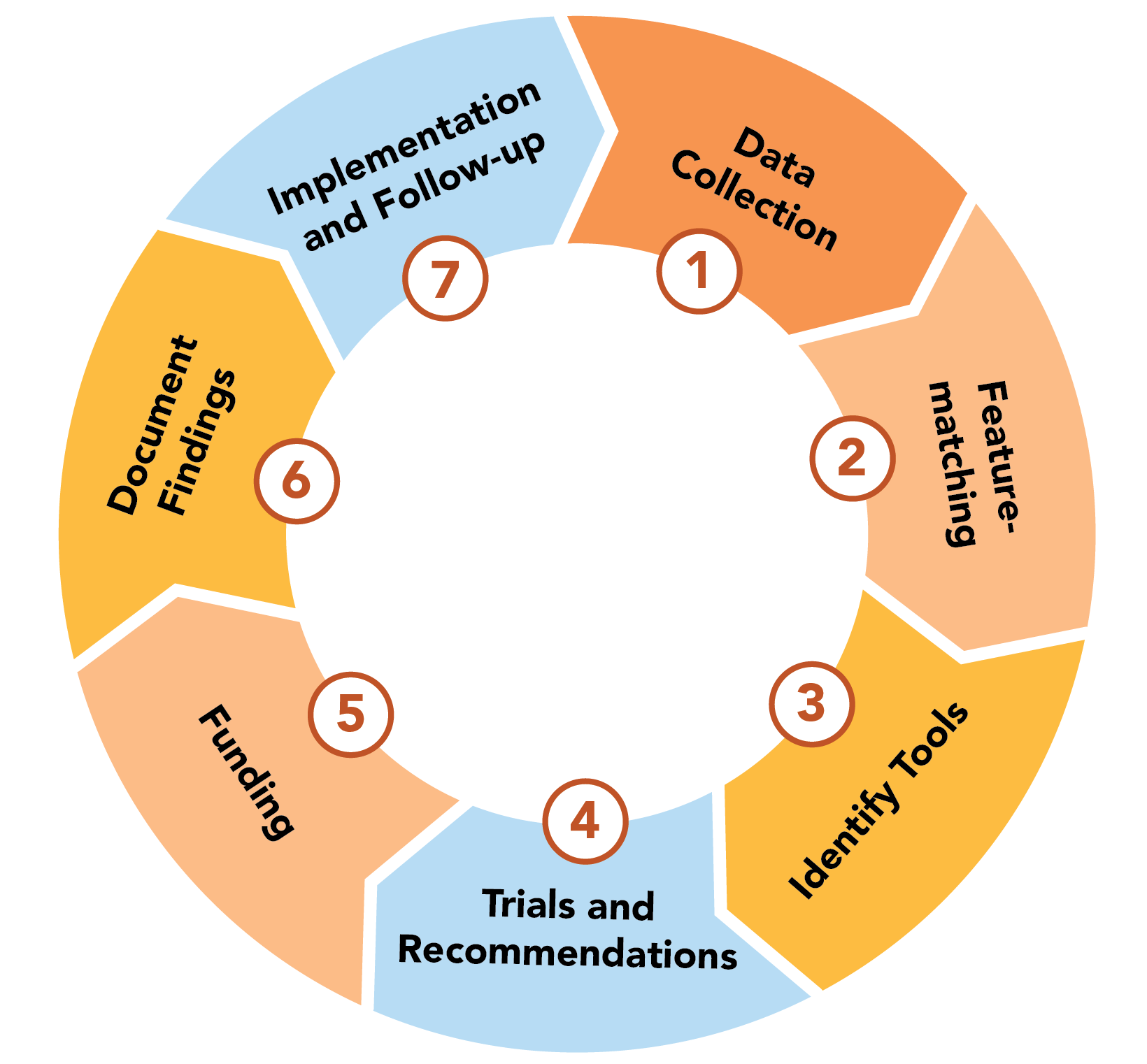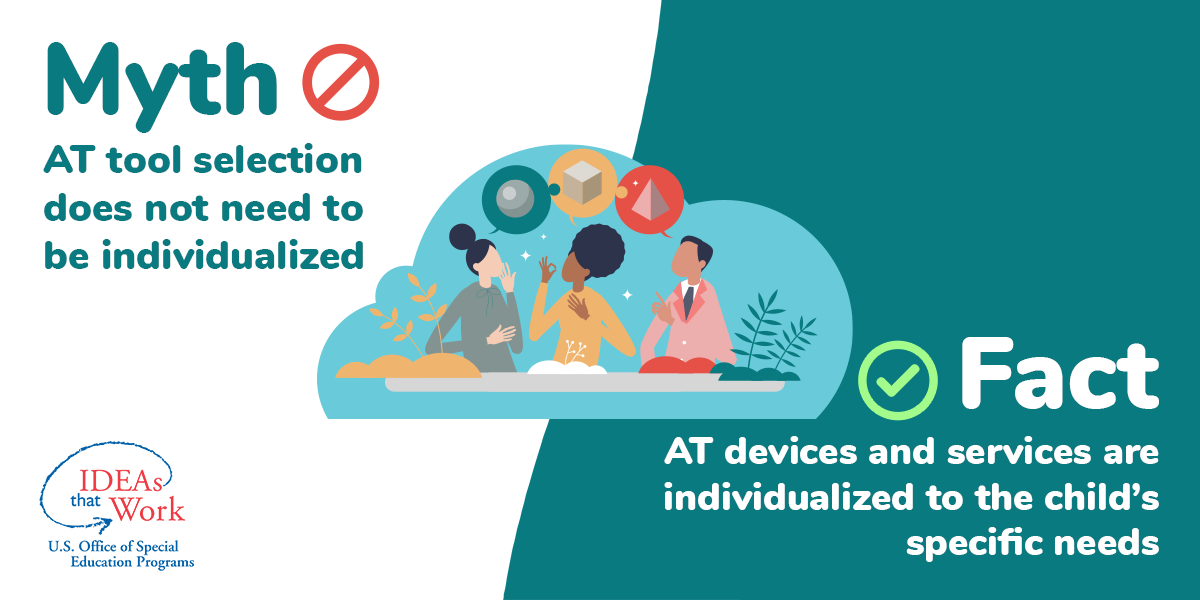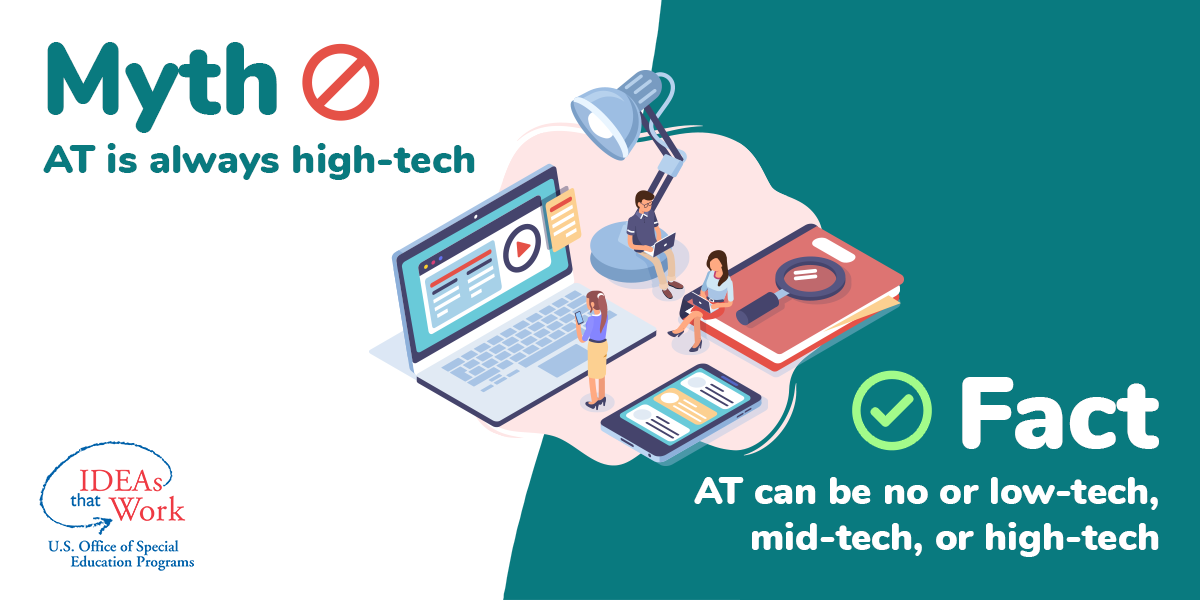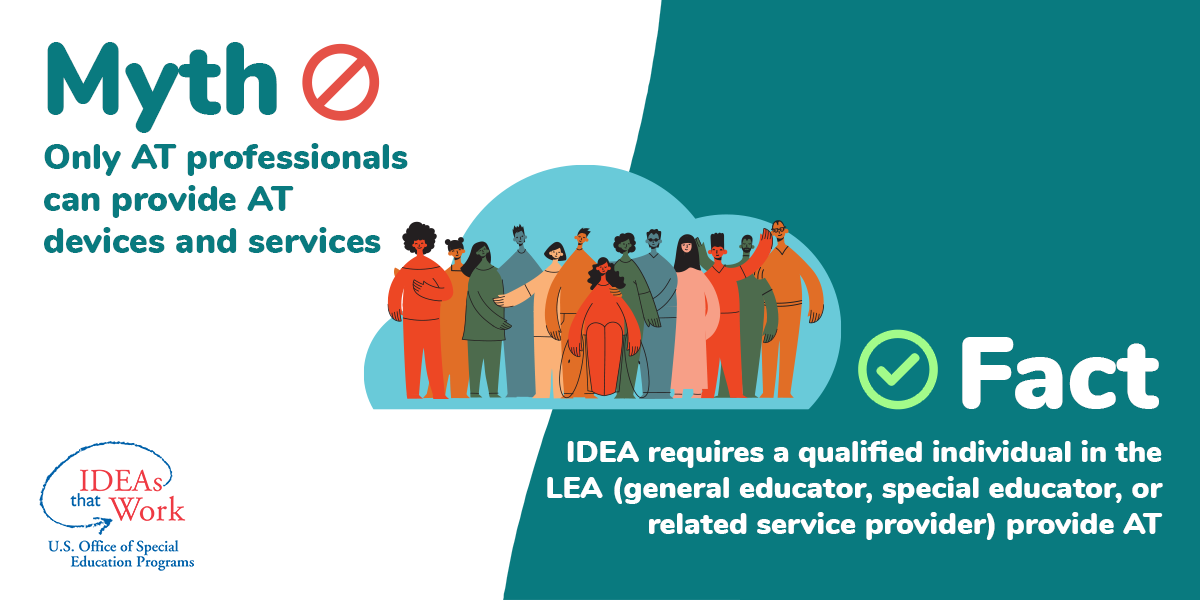Steps of the AT Assessment Process

When the assessment process has been initiated, the assessment team can follow the steps of the AT assessment process to identify AT devices and services that will benefit the student.
To identify features of AT devices that might help a student, it is important to collect data about the student’s needs and abilities, the tasks they are having trouble with, and the environment where they need to accomplish those tasks. Data can be obtained from diverse sources, including past Evaluation Team Reports (ETR), classroom observations, formative assessments from the teacher, and so on. More information about data collection is available in the ATIM module, AT Assessment Process in the School Environment.
The SETT Framework guides IEP teams by ensuring all team members have the same shared understanding about the Student, Environments, and Tasks so that discussion around potential Tools can be productive. During the assessment, the team proceeds through the following problem-solving process utilizing the SETT Framework:
- Strengths, Needs, and Abilities – The assessment begins with an analysis of the student’s strengths and preferences. Next the team will look at the student’s needs, abilities, and skills. These are used to determine the student’s capabilities and functional levels of performance.
- Environments – Relevant environments in which the AT is needed must be considered and will involve discussing various settings and expectations. This may include extracurricular activities in the school or community and homework requirements in the home environment. If the student requires AT to support community and work-related goals in their IEP, these environments may be considered as well.
- Tasks – Tasks are what the student needs to be able to do to access the curriculum and school related activities. These are the school tasks the student is not able to do or finds difficult to complete within the school setting. While a student may have several tasks that are difficult to accomplish, the team will need to prioritize the tasks and focus the AT solutions on a specific functional area of concern (e.g., writing, reading, math).
- Tools – Tools are the AT that will be determined through this process and by matching the features of potential tools to the specific needs of the student.
The SETT Framework is a form that can be used during the AT assessment process to document the student’s needs and abilities, their environments, and the tasks they need to accomplish. A variety of frameworks and tools are available on the AT&AEM website to assist with the AT assessment process.

AEM Tie-In:
The provision and use of accessible formats need to be responsive to a child's individualized needs.
Once the team has a well-rounded understanding of the student’s needs and abilities, they can begin to brainstorm potential features of AT tools and/or devices. One tool available to help identify features of AT is SIFTS. This is an online tool that asks questions about a student’s needs and abilities and connects them to features of AT devices. SIFTS is organized by domains related to a specific area of focus such as reading, writing, or organization, to name a few. After features are identified using SIFTS and other tools, the feature-matching process continues. Using the SETT Scaffold for Tool Selection - Part I - Identifying Tools, the team can list features of AT devices along the top of the page and specific AT devices along the left side column. This form allows the team to determine which AT features needed by the student are available on which device.
As a result of data collection using the SETT framework and SIFTS, teams can use the collected information to prioritize and filter specific AT tools/devices. The AT Selection section of the AT&AEM Center website provides resources to look for AT that match the identified features. In addition, searching by desired AT features can help the team identify specific AT tools/devices. For example, go to an Internet search engine and type the feature plus assistive technology, such as “word prediction assistive technology.” Then, the SETT Scaffold for Tool Selection – Part 2 – Prioritizing Tools can assist teams to document, justify, and prioritize the various AT to find the best match to the student's needs. It is possible that several different tools can meet the student’s needs equally, and as such the team can only then consider the cost and availability.

AEM Tie-In:
Accessible formats can be either digital or paper based.
At this point, the team has likely identified a few specific AT devices for the student to review. The next step is to arrange hands-on trials with those devices. Trials of equipment can occur through OCALI’s Lending Library or one of Ohio’s several short-term regional or state-wide AT lending libraries. Additionally, trials can at times be arranged with AT product vendors; however, vendors sometimes charge fees for equipment loans. Data collection is imperative at this stage of the assessment process as well, because it will provide objective measures of which devices worked for the student. The length of time and type of data that must be collected is determined by the AT assessment team based on the student’s individual needs. A useful guide to assist teams in determining what data to collect and how to collect the data is the document, How Do You Know It? How Can You Show It? (Reed, Bowser, & Korsten, 2004). After the data is collected and analyzed, the team should meet to determine which AT device showed the best results. Once a specific device or set of AT features has been identified, the next phase is the process of writing up a specific recommendation and acquiring the AT. One example of a report template to request medical funding (i.e. Medicaid/Medicare) of an Alternative and Augmentative Communication (AAC) device is the AAC Report Coach.
Under IDEA, AT devices and services must be provided if they are required for the student to receive a Free Appropriate Public Education (FAPE). The student’s IEP team makes this determination. The LEA is responsible for providing AT as identified in the IEP. Ohio Administrative Code indicates that:
- Each school district must ensure that AT devices or AT services, or both, as those terms are defined in rule 3301-51-01 of the Administrative Code, are made available to a child with a disability if required as a part of the child's:
- Special education under rule 3301-51-01 of the Administrative Code;
- Related services under rule 3301-51-01 of the Administrative Code; or
- Supplementary aids and services under rule 3301-51-09 of the Administrative Code.
- On a case-by-case basis, the use of school-purchased AT devices in a child’s home or in other settings is required if the child's IEP team determines that the child needs access to those devices in order to receive FAPE.
(OAC, 2014).
Throughout the assessment process it is important to remember it is the school’s responsibility to provide the recommended AT device, but there are many additional avenues to obtain funding. These might be disability specific agencies, federal and state programs, and philanthropic organizations depending on the students’ and families’ needs.
If the AT will be used specifically to support educational activities and is needed to provide the student with FAPE, then the student’s LEA will likely be the funding source. Section 4, Funding Assistive Technology , describes additional funding sources to explore and under what circumstances those funding sources can be used.
After the AT tool/device has been identified, document the specific set of features in the student’s IEP. This will ensure the AT is available to the student in all environments in which it is needed. AT must be included in IEP form (PR-07) in Section 2: Special Instructional Factors. In addition, documenting in the Assistive Technology subsection in Section 7: Descriptions(s) of Specially Designed Services allows the team to locate the information easily. AT devices and services may also be included and referenced in the following IEP sections:
Front Page: Other Information/Amendments
- Other Information
- Amendments
Section 1: Future Planning
Section 2: Special Instructional Factors
Section 3: Profile
Section 5: Postsecondary Transition and Postsecondary Transition Services
Section 6: Measurable Annual Goals
- Present Levels of Academic Achievement and Functional Performances
- Measurable Annual Goal(s)
- Measurable Objectives/Benchmarks
Section 7: Description(s) of Specially Designed Services
- Specially Designed Instruction
- Related Services
- AT
- Accommodations
Section 8: Transportation as a Related Service
Section 9: Nonacademic and Extracurricular Activities
Section 12: Statewide and District Wide Testing
Section 5 of the AT Resource Guide, Documenting AT in the IEP, addresses how AT can be incorporated in each of these areas. The ATIM module AT Supports and Services in the IEP is another resource that addresses documentation of AT in specific sections of the IEP.
Implementation is a broad term that includes not only setting up the new AT for use during the school day but ongoing monitoring of its effectiveness, as well as conducting updates. Updates might address new content-related material, new tasks to be accomplished while using the AT, or new environments in which the AT will be used. AT assessment is an ongoing process. When changes in the student’s abilities, environments, and/or educational needs are noted, data should be collected, and steps should be taken to determine any needs for additional information or changes to the implementation of AT. Such changes may include the student needing new access tools, due to changes in physical abilities, due to additional vocabulary for content-related subject matter or vocational opportunities, or simply due to increasingly complex curriculum such as going from basic math (e.g., addition/subtraction) to advanced math (e.g., graphs and calculus notations).

AEM Tie-In:
As with AT devices and services, the individuals involved or the process(es) needed to select, acquire, and support the use of accessible formats of educational materials vary according to the child’s needs as determined by the IEP Team.
Another component of implementation is transition. Transitions occur frequently in schools—each time a new school year begins, a student changes classes or teachers, new staff is added, the student enters a new building, and so on. Students using AT benefit greatly from carefully planned transitions. In particular, student records are critical for new staff to review, as they will enable them to understand the abilities of the student, expectations in the educational program, and ways that the AT facilitates expected student participation. In turn, incoming staff should examine the environment and tasks required in the new setting. In short, collaboration between “old” and “new” must take place. For more information about transitions, visit the ATIM module AT Transitions.
By nature of the AT assessment process being an ongoing process, this implies that the implementation of AT is never finished. Data collection should be ongoing, with set times to revisit AT usage at least yearly or more as needed. The ATIM module AT Implementation delves deeper into the topic, looking into AT competence through operational, functional, strategic, and social skills and any necessary monitoring and adjustments.
